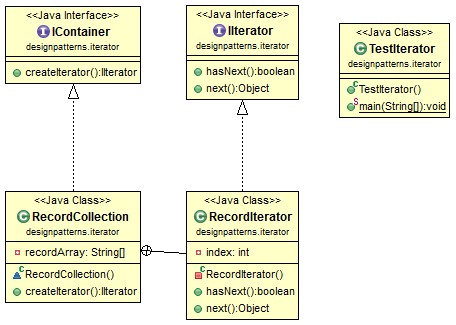Iterator pattern is used to iterate through a collection of objects. It is a commonly used pattern, you probably have used it before. Whenever you sees something like hasNext() and next(), it is probably a iterator pattern. For example, you may iterate through a list of database query record.
Iterator Pattern Class Diagram
Iterator Pattern Java Code
interface IIterator{ public boolean hasNext(); public Object next(); } interface IContainer{ public IIterator createIterator(); } class RecordCollection implements IContainer{ private String recordArray[] = {"first","second","third","fourth","fifth"}; public IIterator createIterator(){ RecordIterator iterator = new RecordIterator(); return iterator; } private class RecordIterator implements IIterator{ private int index; public boolean hasNext(){ if (index < recordArray.length) return true; else return false; } public Object next(){ if (this.hasNext()) return recordArray[index++]; else return null; } } } public class TestIterator { public static void main(String[] args) { RecordCollection recordCollection = new RecordCollection(); IIterator iter = recordCollection.createIterator(); while(iter.hasNext()){ System.out.println(iter.next()); } } } |
Iterator Pattern used in JDK
In java.util package, the Iterator interface is defined as follows:
public interface Iterator<E> { boolean hasNext(); E next(); void remove(); } |
Then there are class that can create an Iterator, e.g., TreeSet#iterator(), HashSet#iterator(), etc.

Great article, its very useful and helpful to know about java design pattern iterator,i was unknown to this but now got to know how to use it.
Basically, an iterator provides an indicates of “looping†over a shown choice of factors.
Thanks a lot.